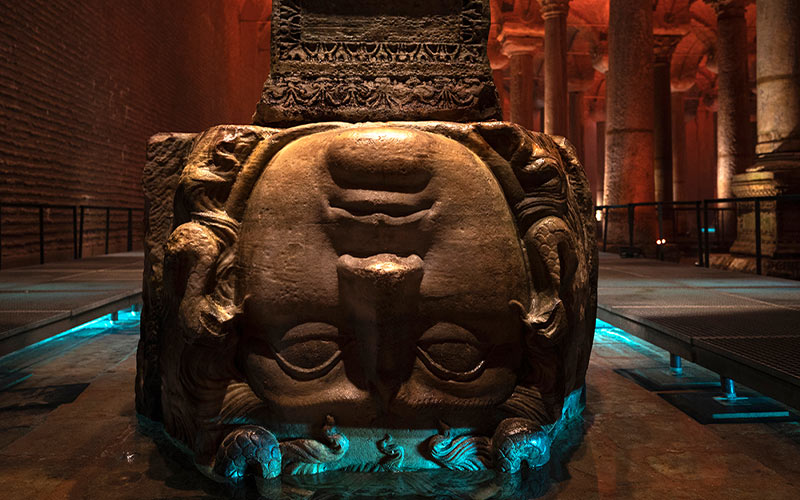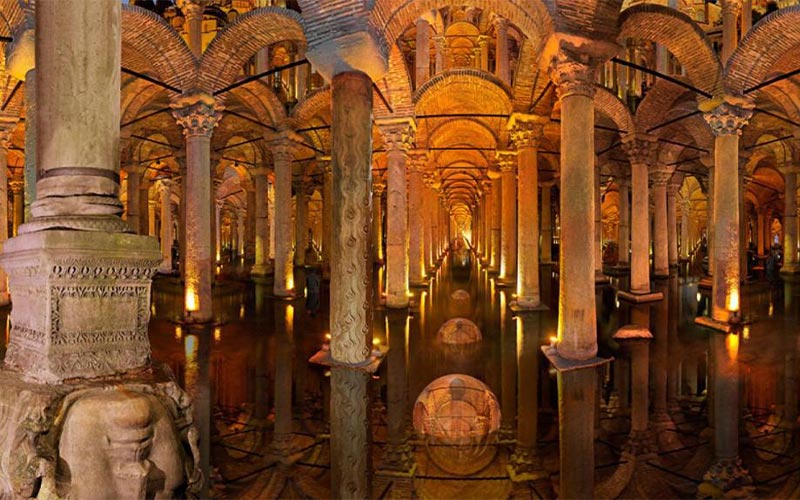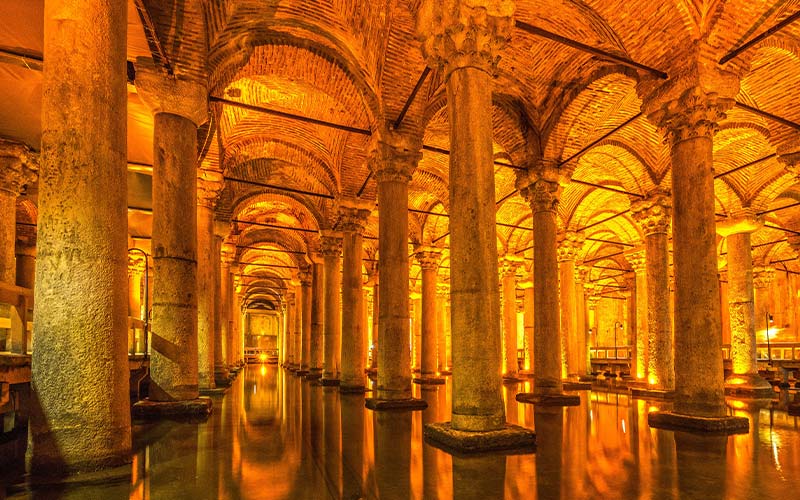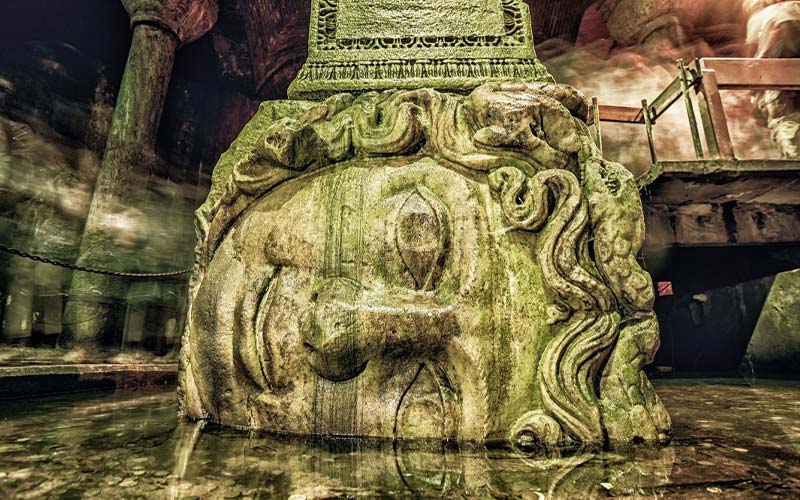Istanbul's Underground Basilica Cistern
Are you tired of the crowd in Istanbul and want to replace the constant hustle and bustle of Istanbul's streets with nothing but silence?
Beneath the houses and buildings on Istanbul's historical Peninsula lies an isolated haven of peace and tranquillity, the Basilica Cistern.
Cistern Basilica is one of the most magical landmarks in Istanbul and undoubtedly one of the most majestic historical structures you shouldn't miss on your trip.
Istanbul's Mysterious Underground Basilica Cistern

It was built by Byzantine Emperor Justinian I and served as a water reservoir for the Great Palace. It can store up to 100,000 cubic meters of water.
The unique feature of the inverted medusa head and the many Roman columns makes the cistern looks like an underground palace at first sight, which is why Turkish people call it "Yerebatan Sarayi", which means "Underground Palace" or "Sunk-into-the-ground Palace".
The outstanding engineering behind the Basilica Cistern has led to it being used on various occasions as a film set. For example, it was used in the film From Russia With Love from the James Bond series. More recently, the intense final scene of Inferno, based on the novel by Dan Brown and featuring the actor Tom Hanks, was also filmed here.
In this guide, you will find everything about Basilica Cistern, including its history, attractions, opening and closing time, how to get there, tickets and more.
History of the Basilica Cistern

Like most tourist sites in İstanbul, the Basilica cistern has a unique history. It got its name because it lay underneath the historical Stoa Basilica, one of the two big public squares of Constantinople.
Basilica Cistern was built by Emperor Justinianus in the 6th century when the city struggled to get water. He ordered the basilica cistern and many other cisterns to be made as water storage tanks to solve the Constantinople water issue and supply the residents with enough water during the siege.
It is believed that the water supply to the cistern is from the Belgrade Forest near the Black Sea, delivered via the 20km of Valens aqueducts.
The city authorities forgot the cistern for a long time after the conquest of Istanbul; however, it was rediscovered in 1545 by the Dutch traveler Petrus Gyllius, who came to explore Byzantine antiquities in the city and observed that the residents were able to obtain water by lowering buckets into a dark space below their basement floors.
Some were even catching fish this way.
He entered the cistern through one of the basements with a flame torch. He sailed in the cistern, took measures of it and counted the columns.
After his discovery, the cistern was renovated by Architect Mehmet Aga from Kayseri during Sultan Ahmet III's period in 1723. The second time, Sultan Abdulhamit II ordered the renovation of the cistern. So, in the Ottomans' era, the cistern was renovated two times but was kept from the public.
In 1985, during the Republic Of Turkey Era, the cistern was cleaned, renovated, and opened to the public in 1987. Today, it is one of the city's most popular tourist attractions.
Architectural Features of Basilica Cistern

It is not an exaggeration when Turkish people call the Basilica cistern an 'underground palace' because once you immerse yourself in the cistern's atmosphere, you will feel like you have stepped through a door that leads to a different universe.
The first thing that will grab your attention in the Basilica cistern is the system of 336 marble columns that hold the roof up, almost resembling a magnificent forest. There are 12 rows of 28 columns, each standing 9 meters high. The styles of the columns are varied, as they were re-used from other monuments and structures.
The walkways in the cistern are placed strategically above the water, allowing people to reach all parts of the cistern.
Among the 336 columns, the most famous are those with Medusa's head as a base. In Greek mythology, Medusa was one of the three gorgons. She was a monster with snakes on her hair and had the power to turn anyone who looked at her to stone.
People believe that the two mammoth Medusa heads were inverted to nullify her gaze's powers. Although these two heads' origins are unknown, some legends say they were brought to the cistern from another building, dating back to the late Roman period.
The Basilica cistern measures 140 meters long and 65 meters wide. It is said that it has a water storage capacity of approximately 100,000 tons.
A particular column inside the cistern known as the "weeping column" is shaped by peacocks, drooping branches, tear reliefs, and carvings. According to rumors, in the 38-year construction of the cistern, 7,000 enslaved people worked, hundreds of them died, and this column was erected in their memory.
The subtle reddish lighting of the cistern lends a magical touch to this beautiful place, while its special acoustics have led to it being used as a stage for music concerts. You'll also find a small restaurant with a terrace at the entrance. Also, when you finish the tour, you can buy a souvenir from the cistern's gift shop. Ensure you have your camera ready because you'll want to take some snaps!
Basilica Cistern Location

It is located in the heart of Sultanahmet, close to other tourist sights such as the Topkapi Palace, Blue Mosque, and the Hagia Sophia.
How to get to Basilica Cistern?
You can reach Basilica Cistern by tram, bus or taxi. If you want to use the bus, you can take the buses around Sultanahmet Square, which stops near the Basilica Cistern.
You can also walk since Basilica Cistern is just a few steps from Sultanahmet Square.
If you are coming from Taksim, the best way is to take the funicular F1 to Kabataş. At Kabataş Station, take the tram T1 and go seven stops to Sultanahmet Station. From here, Basilica Cistern is just 2 minutes away.
What Are The Opening-Closing Hours For Basilica Cistern?
The Basilica Cistern is open daily from 9:00 am to 5:30 pm.
What Are The Ticket Prices For Basilica Cistern?
Ticket prices for students are 5 Turkish Lira, 10 Turkish Lira for locals and 190 TL for foreign visitors.
Important Tips When Visiting Basilica Cistern
- Basilica cistern can be very crowded, so try to get there early in the morning to avoid overcrowding.
- There is a café to buy drinks and snacks and a souvenir shop at the exit of Cistern Basilica.
- It is not allowed to take pictures with a tripod.
- You can only spend Turkish lira, so make sure you bring some cash with you.
Comment
Leave a Comment